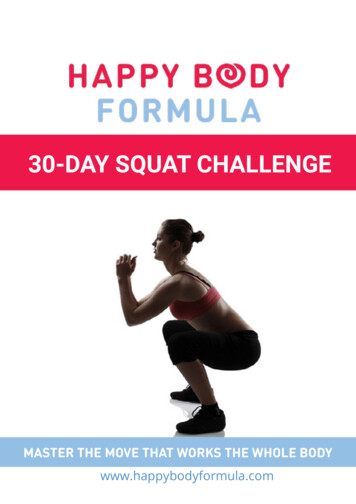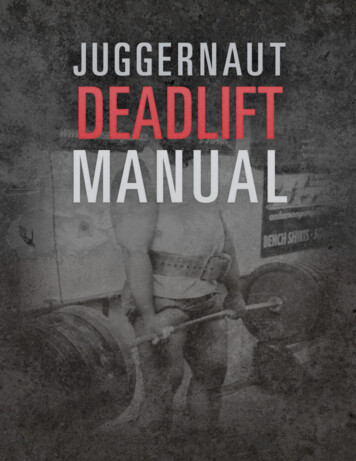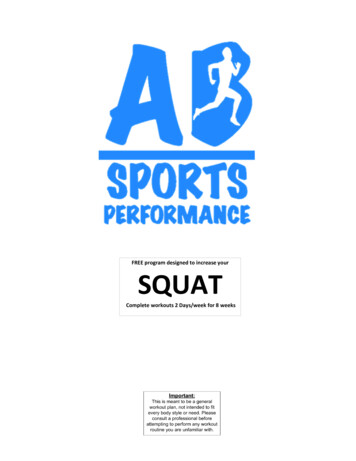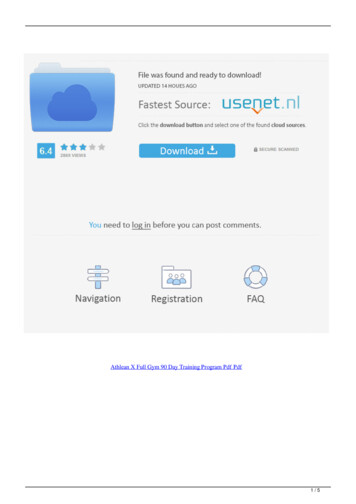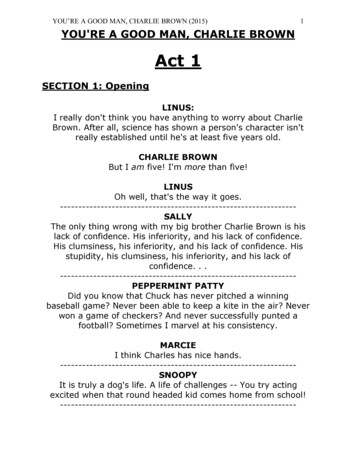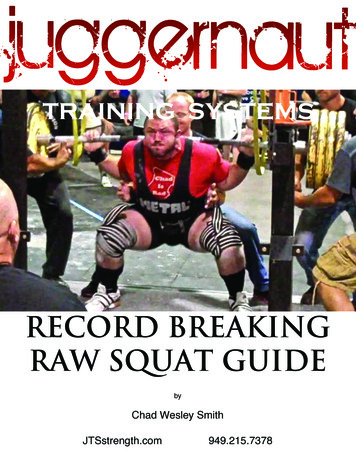
Transcription
RECORD BREAKINGRAW SQUAT GUIDEbyChad Wesley SmithJTSstrength.com949.215.7378
The 900 pound raw squat threshold is a barrier that very few athletes have crossed. Learn from Chad about how you can bring your squat up to record levels.The raw squat is one of the purest measures of total body strength and power, earning it the moniker of “the king of all lifts”. In August 2011, I became the 14th man in history to break the 900 pound barrier in a belt and knee wraps by squatting 905 pounds in August 2011 at the SPF Powerstation Pro/AM, it not only broke the American Record in the 308 weight class, it also represented a 105 pound PR from my 1st powerlifting meet less than 10 months earlier. Squatting is simple, bar on your back, bend your knees, stand up, with a few Miner points thrown in and there is no reason that your training needs to be overly complicated. either I want to take you step by step through my approach to performing the squat and some of my training philosophies that have helped me reach success so quickly in my powerlifting career.Click here to see video of Chad squatting anAmerican Record 905 pounds!!
Shoes, Wraps and Belt Maximizing your squatting abilities begins before you get under the bar. Choosing proper footwear is the starting point for moving maximum poundages in the squat. At my Mirst powerlifting meet, I squatted 800 pounds while wearing Nike Frees, which garnered me many negative comments from various anonymous internet tough guys, who needed to worry more about their technique and training than footwear and while I still support that type of thinking, if you are going to train to squat big, you should invest in a good pair of shoes to do so in. The type of footwear you select should be dependent on your squatting style. I wear Adidas Ironworks Olympic lifting shoes, which have a fairly large heel and hard sole, these type of shoes are ideal for a lifter with a narrow to medium stance who allows their knees to have some forward movement. Lifters who use a slightly wider stance and focus on forcing their hips back as much as possible will be well served to squat in shoes like Adidas Sambas or Chuck Taylors. The Sambas have a very slight heel on them, which will beneMit lifters with poor ankle mobility which limits their ability to get proper depth. Click here to see Chad squat 800 athis first meet in Nike Frees!!
The other pieces of equipment to consider for the raw squatter are the belt and knee wraps. When looking for a good belt, I would suggest a single prong powerlifting belt. Single prong belts allow for more Mlexibility than lever belts and just as much stability. Knee wraps can have a great impact on increasing poundages for raw squatters. The key characteristic to look for when shopping for knee wraps, is rebound power. Geared squatters require stopping power, while raw squatters require more rebound power as they will not receive any pop from a suit. I wear Elite Fitness System’s Heavy Wraps. As a general rule of thumb, striped knee wraps are generally better suited for raw lifters than solid color wraps. I was fortunate enough to have my good friend Brian Carroll’s handler, Tony Garland, wrap my knees for my record breaking 905 pound squat. Here is the technique he utilized for my squat and Brian’s 1185 multiply world record at 275s Click Here to see this record breaking knee wrap technique!!Kevin Torres, 565 squat at 165 bw and 17 yearsold, knows the importance of a good knee wrap.Here he is getting wrapped by EliteFTS sponsoredathlete, Dave Kirschen before one of his squats atthe 2011 SPF Powerstation Pro/Am
WarmupOnce you are properly equipped to squat with the right shoes, wraps and belt, it is time to prepare your body for maximum performance with a proper warmup that improves mobility, prevents injury and prepares you for maximum performance. A well organized warmup will increase core temperature, improve mobility, activate the musculature needed for the training and prepare the central nervous system for maximum performance. A proper warmup is also a simple way to improve the lifter’s general physical preparedness, if you are left gasping for air from a warmup you are either being excessive in your pre training routine, or you are tremendously out of shape, my guess is the later. My squat training warmup is as follows 1)Incline Treadmill Walk 5 min2)Joint Circles x10 for each: neck, shoulders, arms, hips, good mornings. Upper body mobility is also important for squatting, to allow you to get into proper position under the bar.3)Quadruped Hip Mobility x10 each: Bent leg raise, straight leg raise, donkey kicks, forward and backward knee circles4)Skipping, shufMling and high knee drills 1 3x10 yds each5)Glute Activation Drills x10 20 of either Band Resisted Walks or Glute Bridges, if you have issues with your knees collapsing inward during the squat, you need to be doing glute activation work6)Box Jumps x5 15 total: Jumps will provide a post activation potentiation effect to your squatting through the stimulus it provides to the central nervous system. Here is Chad warming up before the 2011 SPFPowerstation Pro/AM with EliteFTS sponsored lifters BrianCarroll and Matt Kroc looking on.Click here to see a video of a typical squat training warmupfor Chad!
While this amount of warmup may seem daunting to someone with low GPP, it would serve many lifters well by improving their aerobic capacity (which will allow them to perform more high quality work within a training session, not be hufMing and pufMing while approaching the bar and have some gas in the tank at the end of a meet to pull a big deadlift), enhancing mobility (which will aid in injury prevention and allow you to hip depth more easily), increasing athleticism/kinesthetic awareness (which will make technical adjustments easier to make) and enhancing your explosive power. After completing this general warmup, I will get under the bar and if let’s say I was going up to 765x3 (in knee wraps) that session my warmup would be as follows Bar x15, 135x5, 225x5, 315x3, 405x2, 495x1, Add Belt, 585x1, Add Wraps, 675x1, 765x3Setup and Walkout One place that too many lifters miss squats, is before they even begin the lift, in the setup and walkout. A good setup is critical to squatting big weights. A simple rule when setting up is that if you are comfortable holding your position, it isn’t tight enough. My process of setting up and walking out is as follows 1) Set your hands, I use a thumbless grip with my thumb set on the rings. This is a relatively narrow grip for a bigger lifter, but I deMinitely feel that a narrow hand position allows for a tighter upper back. 2) Pull your shoulder blades together before ducking under the bar, then as you duck under the bar, set one shoulder blade and then wedge the other in and then dig the bar into the middle of your traps. 3) Force your chest up as you bring your hips underneath you to bring the bar out of the rack with your hips, not your legs, keeping your eyes up throughout the walkout. 4) Walk your dominant foot out (in my case my right), then in one step set your opposite foot, and in one more step set your dominant foot. You should not need more than 3 steps to walk a weight out and have your feet set properly. 5) Pull as much air into your belly as possible, you should feel like you are stretching your belt with your abdominal pressure. This pressure should feel like it is going to cause your head to explode or eyes to pop out. A strong setup and walkout is critical to a big squat. You can’t Qinish well if you don’t start well.
Technical Cues To be elite at any power/speed discipline, your technique must become automatic. If you must think about every aspect of your technical execution during the squat, you will not be able to maximize your force production due to the slower neural Miring patterns. For this to happen you must master your technique in every rep of training from an empty bar until your Minal rep of your work sets at every session, so that when you are on the platform you can shut your brain off and just perform. There are Mive technical cues that I think about during every training squat; 1) Get Tight, 2) Commit to the Descent, 3) Head into the Bar, 4) Knees Out, and 5) Accelerate. 1) Get Tight Creating tightness throughout the entire body is a product of three things, proper set up which I have already addressed, getting big air into your belly draw as much air into your belly as possible, you should try to stretch your belt with your abs. There is a reason that so many great squatters have big waists, because a larger waist provides a greater base of support for big weight on your back, so expand your waist as much as possible with big air. The 3rd key to tightness is to squeeze the bar down with your hands. You want to squeeze the bar in your hand which will send a neural response of tightness throughout your entire body and pull the bar down onto your back, as if you are at the bottom position of a lat pulldown, this will Mlex your lats and give you a stronger support for the weight on your back. 2) Commit to the Descent too many lifters seem to be intimidated by big weight on their backs and slow down their descents when compared to earlier lighter sets, this causes them to waste energy during the eccentric portion of the lift and to not exploit their stretch reMlex which diminishes their power out of the hole. You have to Migure out how fast YOU can descend and still maintain your tightness and technique. Descending quickly with big weight is a skill and must be practiced. Shane Haamman, a tremendous squatter and Olympic weightlifter, really knows about committing to the descent. Click here check out this video to see Shane crush some huge weight with a very rapid eccentric phase.
Now I’m not saying that you have to have such a rapid descent, as Shane does, the important idea here is to descend with your max, the same way you do with your Mirst warmup rep. 3) Head into the Bar The most frequent ways that athlete’s miss squats is by falling forward due to their chest collapsing. This could be an issue of upper back weakness, poor setup or letting your head fall forward when reversing the weight. Throughout your squat you need to push your head back into your traps, this particularly needs to be cued when you are reversing the weight out of the hole. Pushing your head back will cause your chest to stay up and allow you to maintain a neutral back position. A simple teaching tool to cue this is to put on a baseball hat, backwards and tilt your head back so that the bill of the hat touches your traps.If you feel solid with your technique in this aspect and feel that strength is lacking in your upper back, you need to be hitting your shrugs, rows and chinups hard. Because it is static/isometric strength required to hold a good upper back position during your squats, try holding the contraction on your Minal rep for 10 15 seconds (about the time that a ME single takes). 4) Knees Out Between the meets where I squatted 865 and 905, I decided to slightly widen my stance and as your stance widens, a common physical/technical breakdown is knees collapsing inwards or valgus collapse. Valgus collapse could be a symptom of poor glute strength or just a lack of focus on this technical point. On the downward portion of the lift, you must force your knees out to allow yourself to ‘sit between your knees’ and on the upward portion of the lift you should force your knees out to allow you to fully utilize your glute and hip strength. If you struggle forcing your knees out you must strengthen your glutes. To do this is simple, I would suggest utilizing band walks, as seen in my warmup video, and band around the knees squats. To perform these, loop a micro mini/mini/monster mini depending on strength, band once (making it into a circle that is half of its original size) and step through it so that the band so that it is around your knees and step out into your regular stance. Now you will feel the band pulling your knees in and your must actively force them out to stretch the band; I would suggest doing band around the knees squats during all your warmup sets and any submaximal work sets. 5) Accelerate I have often joked that the reason I squat so much isn’t because I’m so strong, but rather because I’m so fast. A conscious focus on accelerating the bar through the top portion of the lift is the simplest way to avoid sticking points. The more force you can generate at the beginning of the lift, the easier each of the following parts will be. During every rep of your training, blast the weight out of the hole, all the way to the top and when you are in a meet, your body will know to accelerate through your sticking points.
The seated box jump is my favorite method of developing explosive lower body strength for the squat. These do a great job of breaking the stretch shortening cycle and will force you to turn on as many motor units as possible, as quickly as possible to generate force with static overcome by dynamic strength. Check out Chad doing at 45” seatedbox jump while wearing a 30 poundweight vest.Here is a sample 12 week jump training cycle to enhance your speed in the squat Week 1 Seated Box Jumps wearing 50# weight vest for 6 sets of 3 jumps to 80% of your maximum box height. Week 2 Seated Box Jumps wearing 50# weight vest for 5 sets of 2 jumps to 90% of your maximum box height.Week 3 Seated Box Jumps wearing 50# weight vest for 4 sets of 1 jump up to a new maximum. Week 4 (Deload) Seated Box Jump without a vest for 3 sets of 3 jumps to 75% of your new maximumWeek 5 Seated Box Jumps wearing a 25# weight vest for 6 sets of 3 jumps to 80% of your maximum box height.Week 6 Seated Box Jumps wearing a 25# weight vest for 5 sets of 2 jumps to 90% of your maximum box height.Week 7 Seated Box Jumps wearing a 25# weight vest for
Ironworks Olympic lifting shoes, which have a fairly large heel and hard sole, these type of shoes are ideal for a

